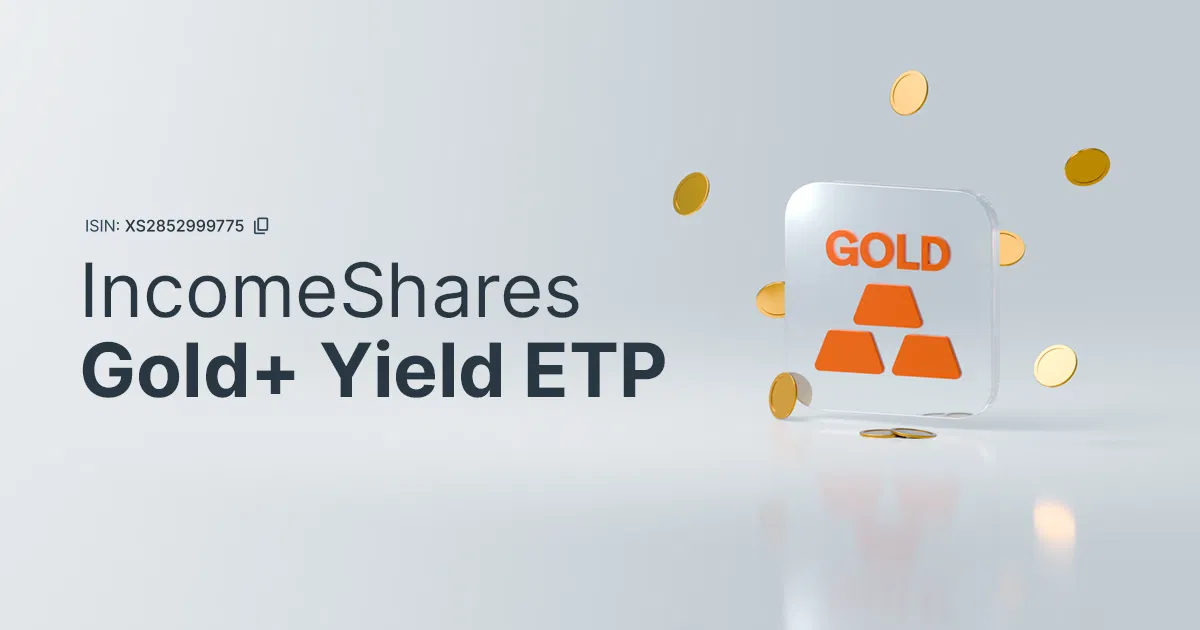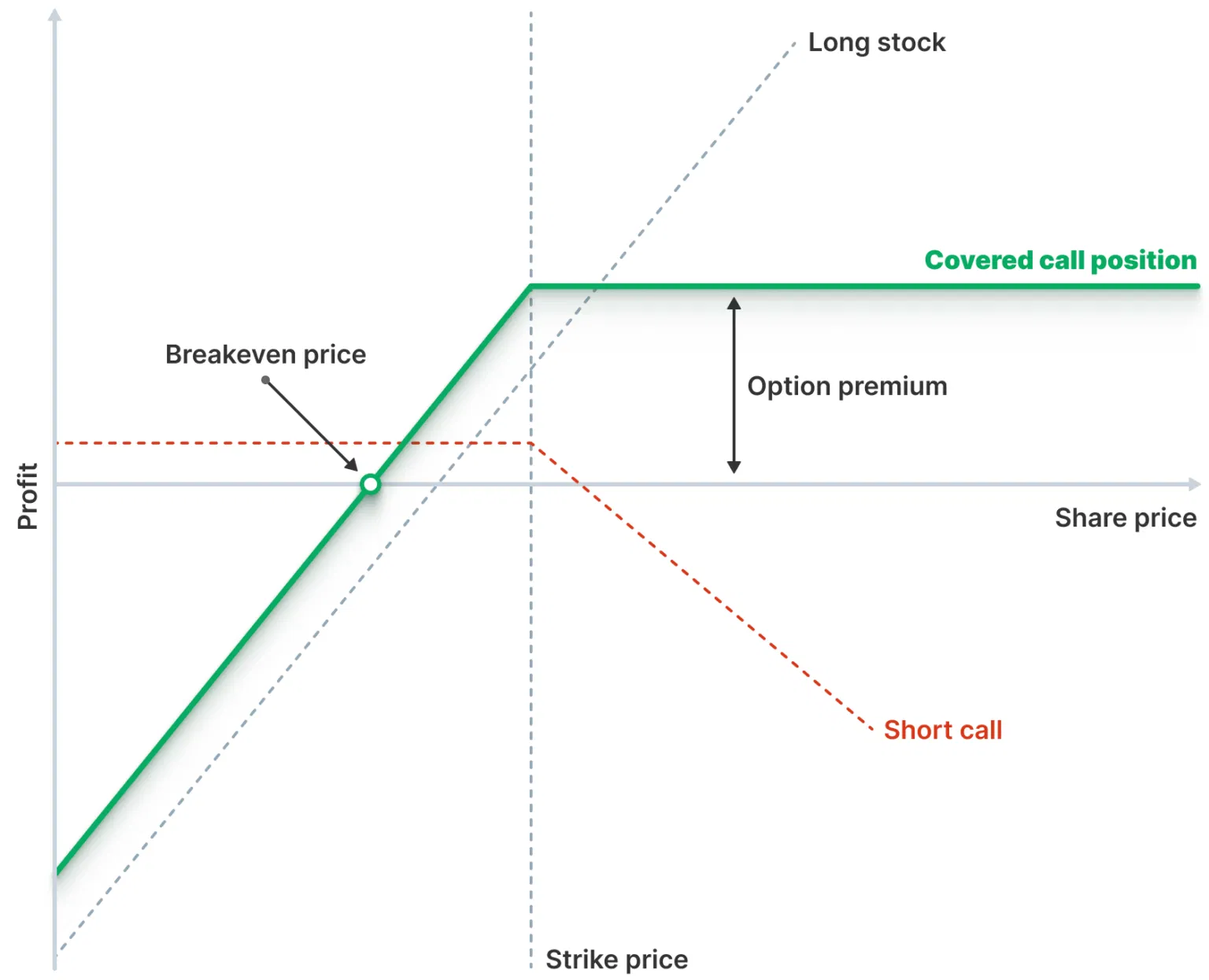
Author
Jonathan Hobbs, CFA
Date
21 Aug 2024
Category
Market Insights
IncomeShares Gold+ Yield ETP
Your capital is at risk if you invest. You could lose all your investment. Please see the full risk warning here.

Strategy Description
The IncomeShares Gold+ Yield ETP (Exchange Traded Product) seeks to provide exposure to gold while generating monthly income through a covered call also known as “buy and write” options strategy. The Gold covered call position is created by buying SPDR® Gold shares (NYSE: GLD) and selling an equivalent amount of American style “at-the-money” or up to 5% “out-of-the-money” SPDR® Gold call options. These options have one week to expiry and are rolled over on a weekly basis to maintain the position.
In return for selling the SPDR® Gold call options, the fund receives a premium. From the weekly premium received from the sale of the call options, the ETP pays a monthly yield to investors. The strategy enables the fund to retain upside exposure to SPDR® Gold’s share price, up to the options strike price.
What are SPDR® Gold Shares?
SPDR® Gold Shares is one of the largest and most liquid gold ETFs (Exchange-Traded Funds) that aims to track the price of gold. The primary objective of SPDR® Gold Shares is to provide investors with an efficient and cost-effective way to access the gold market. Each share represents a fractional ownership of the trust, which holds physical gold bullion.
GLD seeks to mirror the performance of the price of gold bullion. The value of the shares is directly linked to the price movements of gold, offering investors exposure to the precious metal without the need to physically store it.
Why invest in gold?
Gold has served as a store of value for thousands of years and possesses tangible value due to its practical applications in jewellery and electronics. Also, unlike fiat currencies, the supply of gold is relatively limited. Throughout history, few investments have matched gold’s popularity as a safeguard against a wide range of challenges such as inflation, economic uncertainty, currency fluctuations, and even war.
Although gold is not considered a strategic asset class, there are tactical reasons to consider including it in a portfolio. Due to its low correlation with other asset classes like stocks and bonds, gold can enhance portfolio diversification. Its role as a “store of value” can help mitigate risk during periods of market volatility and economic uncertainty, potentially serving as a hedge against inflation. Additionally, gold has historically shown an inverse relationship to the U.S. dollar, often rising in price as the dollar weakens.
Gold has long been seen as an attractive investment but the primary reasons to buy it are:
1. Diversification: The economic forces that determine the price of gold differ from those influencing many other asset classes, such as equities and bonds. This negative or low correlation to other asset classes makes gold an attractive opportunity for investors looking to diversify their portfolios and reduce their overall portfolio risk.
2. Hedge Against Inflation: During inflationary periods, the purchasing power of the dollar declines, prompting central banks to raise interest rates. When inflation rises faster than interest rates, commodities like gold can outperform traditional financial assets. As the dollar’s value declines, investors turn to gold and other safe, stable investments to protect their wealth from inflation. However, it’s important to note that gold doesn’t always rise during inflation, and it’s best considered as a store of value and a long-term investment to be held for years.
3. Safe-Haven Asset / Wealth Preservation: In the volatile world of finance, where significant market swings, economic crises, currency devaluations, and geo-political instability often emerge, gold has stood as a beacon of stability acting as a safe-haven asset throughout history. Also, gold is resistant to purchasing power erosion. The precious metal can only be dug up from the earth, it cannot be ‘printed’ like money, so its relatively fixed supply helps protect its value.
Gold is a reliable store of wealth, consistently retaining its value over time. Unlike fiat currencies or stocks, which can depreciate due to inflation, economic instability, or during periods of increased geo-political tension, gold’s intrinsic worth endures.
Investing in Gold vs. IncomeShares Gold+ Yield ETP
Investing in gold and in IncomeShares Gold+ Yield ETP represents two different approaches to gaining exposure to gold. Let’s break down both options:
1. Investing in Gold
There are several ways investors can invest in gold. One of them is buying physical gold, like bullions or coins. Alternative ways are buying gold ETFs, mutual funds, futures or options contracts, which generally track closely the price movements of gold.
Gold is a non-yielding asset and returns from investing in these products entirely depends on the movements in its price.
2. IncomeShares Gold+ Yield ETP
The IncomeShares Gold+ Yield ETP provides investors with exposure to gold while delivering a regular monthly yield – an advantage that pure gold investments typically lack. The yield is generated through the writing of covered call options. The ETP maintains a continuous long position in SPDR® Gold shares, which track the price of gold. However, it’s important to note that the ETP may not fully replicate the price movements of gold, as the covered call strategy can sometimes cap the potential for upside gains.
Understanding the Covered Call Strategy
The covered call strategy is a method used to generate additional income from an investment. The strategy involves maintaining a long position in an asset, while simultaneously selling or “writing” a call option on that same asset. The call gives the option buyer the right, but not the obligation, to purchase the asset at a predetermined price known as the strike price within a specified timeframe known as the expiry date.
The primary goal of this strategy is to generate additional income from the premium received for selling the call option. This income can provide a buffer against potential losses if the asset’s price declines. However, if the asset’s price rises above the strike price, the seller of the covered call is likely to be called away and be required to sell the asset at the strike price and thus forfeits any further gains above the strike price.
The strategy is termed “covered” because the seller already owns the underlying asset, reducing the risk associated with having to purchase it at a higher market price to fulfil the obligation if the call option is exercised.
FIGURE 1: Covered call pay off diagram :

Covered Call in Different Market Conditions
Covered call writing is most effective in a neutral to moderately bullish market, where significant price increases are not expected. However, in a strong uptrend, it restricts the upside potential, as the underlying asset’s price could rise well above the strike price.
1. Up Trend: In a strongly rising market if the price of SPDR® Gold shares at expiration is above the strike price, the fund has two choices:
a) The fund retains the premium received from selling the call option and allows the option to be exercised, meaning it would sell the SPDR® Gold shares at the predetermined strike price.
b) Alternatively, the fund may prefer not to sell the SPDR® Gold shares. In this case, the existing options contract can be rolled over to avoid delivery.
Rolling Options Forward
Rolling options forward typically involves either letting the existing options to expire or closing out the existing call option while simultaneously opening a new one with a later expiration date and possibly a different strike price. This technique is used to avoid selling the asset when the original call option is approaching or is at expiration, and the underlying price is above the strike price.
2. Down Trend: If SPDR® Gold shares decline and the share price falls below the strike price of the call option at expiration, the fund would face a loss in its share holdings. However, this loss could be partially or fully offset by the premium received from selling the call option.
3. Within a Trading Range: If SPDR® Gold shares fluctuate within a narrow range and the share price remains below the strike price at expiration, the fund will retain both the premium received and the SPDR® Gold shares. The strategy’s maximum profit potential is achieved if, at expiration, the SPDR® Gold share price is at or near the strike price of the call option.
Benefits From Covered Calls
Income Generation: The primary advantage of a covered call strategy is its ability to generate additional income by selling call options, thereby enhancing overall returns. If the price of the underlying asset remains below the strike price throughout the option’s duration, the fund retains both the premium and the asset itself.
Downside Protection: The premium received from selling call options offers some protection against moderate declines in the underlying asset’s price. Additionally, this premium reduces the breakeven point of the position and helps lower overall portfolio volatility.
Enhanced Returns in Sideways Markets: In markets with range-bound or moderately bullish trends, a covered call strategy can deliver consistent returns through the premiums collected.
Risks From Covered Calls
Limited Upside Potential: The maximum profit from a covered call strategy is capped at the strike price. If the underlying asset’s price reaches the strike price at expiration, the strategy achieves its highest profitability. However, if the asset’s price rises significantly above the strike price, the strategy will forgo any additional gains beyond that level.
Obligation to Sell: If the underlying asset’s price exceeds the strike price at expiration, the writer of the covered call is obligated to sell the asset at the strike price. To mitigate this risk, the writer might choose a higher, out-of-the-money strike price, which allows to preserve more of the upside potential of the underlying for the duration of the strategy. However, the further out-of-the-money calls typically generate lower premium income.
Choosing Out-Of-The-Money vs. At-The-Money Strike Price
If the fund holds a bullish short-term outlook on gold, it might opt for a call option with a higher, out-of-the-money strike price to retain more of the SPDR® Gold shares upside potential throughout the duration of the strategy. However, this choice will typically result in lower premium income.
Conversely, if the fund has a neutral, negative, or mildly bullish view on gold in the short term, it could select an at-the-money call option with a strike price close to the current share price.
The fund will choose the most suitable strike price based on current market conditions, gold’s price trend, short-term expectations, and implied volatility, all while adhering to the covered call strategy.
Glossary:
Call option: A call option is a derivative contract which gives the option buyer the right to buy a specified asset at a specified price during a specified period. Upon exercise of that right, the option seller is obliged to sell the underlying asset to the option buyer.
Strike Price: The strike price or exercise price is the agreed price at which the underlying asset will change hands if the option is exercised. It is the price for which the underlying asset can be bought (in the case of a call option) or sold (in the case of a put option) if the buyer of the option elects to exercise its rights.
In-the-money: A call option is in-the-money if the strike price of the option is lower than the price of the underlying asset.
At-the-money: A call option is at-the-money if the strike price of the option is the same as the price of the underlying asset.
Out-of-the-money: A call option is out-of-the-money if the strike price of the option is higher than the price of the underlying asset.
Premium: The premium is the cost or price of the option. It is the amount paid by the buyer of an option to the seller of an option.
Expiry date: The expiry date of the option (also known as maturity date, exercise date, or declaration date) is the last day on which the option may be exercised.
American style options: American style options can be exercised by the buyer at any time from the date of purchase up until (and including) expiry date.
Your capital is at risk if you invest. You could lose all your investment. Please see the full risk warning here.
Related Products:
Strategy
Covered Call
Distribution Yield
12.55%
